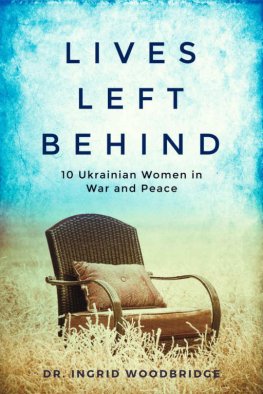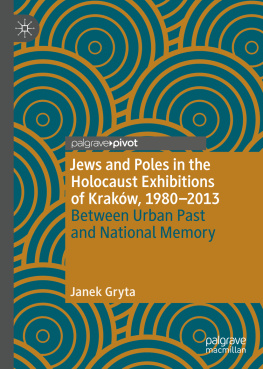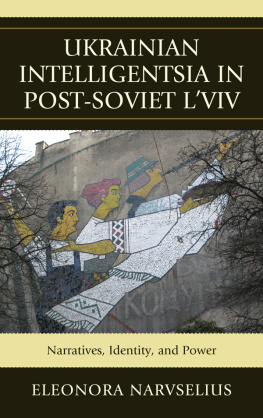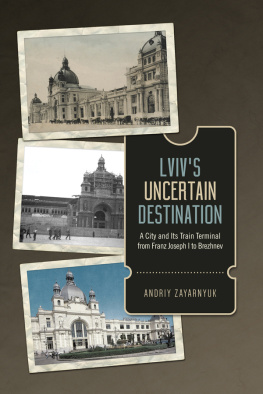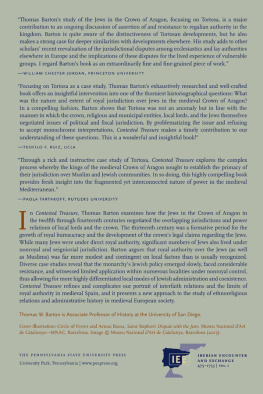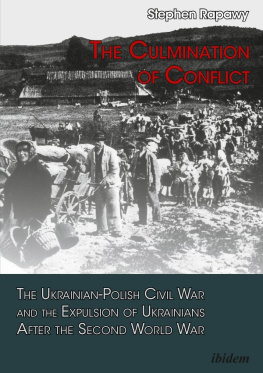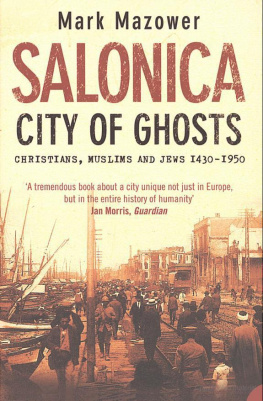Lemberg, Lww, Lviv, 19141947:
Violence and Ethnicity in a Contested City
Central European Studies
Charles Ingrao, founding editor
Gary B. Cohen, editor
Howard Louthan, editor
Franz A. J. Szabo, editor
Daniel L. Unowsky, editor
Lemberg, Lww, Lviv, 19141947:
Violence and Ethnicity in a Contested City
Christoph Mick
Purdue University Press
West Lafayette, Indiana
Copyright 2016 by Purdue University. All rights reserved.
Printed in the United States of America.
Licensed edition with permission from Otto Harrassowitz publishing company,
Wiesbaden Otto Harrassowitz GmbH & Co. KG, Wiesbaden, 2011.
The translation of this work was funded by Geisteswissenschaften InternationalTranslation Funding for Humanities and Social Sciences from Germany, a joint initiative of the Fritz Thyssen Foundation, the German Federal Foreign Office, the collecting society VG WORT and the Brsenverein des Deutschen Buchhandels (German Publishers & Booksellers Association).
Cataloging-in-Publication data on file at the Library of Congress.
Mick, Christoph, author.
[Kriegserfahrungen in einer multiethnischen Stadt. English]
Lemberg, Lww, Lviv, 1914-1947: Violence and Ethnicity in a Contested City / by Christoph Mick.
pages cm.(Central European studies)
Includes bibliographical references and index.
ISBN 978-1-55753-671-6 (pbk.: alk. paper)
ISBN 978-1-61249-391-6 (epdf)
ISBN 978-1-61249-392-3 (epub)
1. Lviv (Ukraine)History20th century.
2. World War, 1914-1918UkraineLviv.
3. World War, 1939-1945UkraineLviv.
4. JewsUkraineLviv.
5. Lviv (Ukraine)Ethnic relations.
I. Title.
DK508.95.L86M53513 2016
947.79dc23
2015027352
Cover image: Austrian postcard from 1915, commemorating the reconquest of Lviv, June 22, 1915.
To Helen
Contents
The territories of todays Baltic states, western Belarus, and western Ukraine have had a particularly complex and, at times, troubled history over the last one hundred years. They belonged to the Tsarist and Habsburg empires before 1914 and saw much fighting and repeated changes in political control during and just after World War I. During the 1920s and 1930s they were governed by the independent Baltic and Polish republics, and then after autumn 1939 experienced new devastating warfare and shifted back and forth between Nazi and Soviet control. After 1945 they all fell under the rule of the Soviet Union, which imposed on them its political, economic, and social systems.
Christoph Micks book tells a compelling story of how the inhabitantsCatholic Poles, Catholic and Orthodox Ukrainians, Jews, and othersin the old capital of Austrian Galicia experienced the traumas of the two world wars and the successive sweeping political changes. This book originated as a Habilitation thesis for the University of Tbingen and was initially published by Otto Harrasowitz Verlag in 2010 as Kriegserfahrungen in einer Multiethnischen Stadt: Lemberg, 1914-1947 [War Experiences in a Multiethnic City: Lemberg/Lww/Lviv, 1914-1947]. This English version represents a revised and shortened version of the German volume. It is a study of great originality based on a large body of archival research in Lviv, Kiev, Warsaw, and Moscow as well as a wealth of contemporary printed sources and scholarly studies. In Micks accounting, political control over the city changed hands some seven times between 1914 and 1947. Before World War I, there were serious political and social tensions among Poles, Ukrainians/ Ruthenians, and Jews in Lemberg/Lww/Lviv, but only limited and infrequent violence. The changes of control over the city during the war led to new power relations, increased inter-group frictions, and episodes of shocking violence. After a brief period of Ukrainian rule, incorporation into an independent Polish Republic in late November 1918 led to intensified civil conflict and new large-scale attacks on Jews. Over the next two decades, the Polish government tried to suppress Ukrainian nationalism in the city and the surrounding region and persecuted Ukrainian nationalist leaders. Antisemitism increased sharply during the 1930s. After the outbreak of World War II, the city experienced first Soviet occupation, then Nazi occupation, and finally Soviet conquest. The Nazis deported and murdered nearly all of the large Jewish population, and at the end of the war the Soviet forces expelled the Poles who had not already been deported or murdered.
Mick offers a vivid analysis of how the citys inhabitants experienced the changes in political control and government policies toward the various national and religious groups. He argues persuasively for focusing on just how individuals and groups experienced the events that transpired and how they perceived their meaning if we are to understand the impacts and legacies. Mick demonstrates persuasively how the longer term ethnic and national politics and ideology of the inhabitants themselves shaped their experiences and understandings of war and peace and how they were prepared to deal with each other. The wide scope of Micks study and his compelling account of the successive changes in relations among the different language and religious groups who once lived as neighbors in Lemberg/ Lww/Lviv adds fascinating new dimensions to our knowledge of the travails of Central and East-Central Europe during the bloody twentieth century. The book is a most welcome addition indeed to the series, Central European Studies.
Gary B. Cohen
Series editor
This is the revised and shortened English edition of my book Kriegserfahrungen in einer multiethnischen Stadt: Lemberg 1914-1947 published in 2010 in the series of the German Historical Institute in Warsaw by Harrassowitz. I cut those parts of the book which did not deal explicitly with war and war remembrance and added some material which had become available since the German edition was published. Some of the ideas I fleshed out in certain chapters of this book I had discussed previously in other publications, journals and edited volumes, but all were revised and updated for this publication.
The translation of the book was funded by the program Geisteswissenschaften International, jointly financed by the Fritz Thyssen Stiftung, VG Wort, Brsenverein des Deutschen Buchhandels and the German Foreign Office. I am very grateful to these institutions.
The research for the book was supported by a three month grant of the German Historical Institute in Warsaw. The Alexander von Humboldt Foundation awarded me a Feodor Lynen grant which gave me the opportunity to spend 1998 in Warsaw. Special Research Area (Sonderforschungsbereich) 437 of the German Research Foundation on War experiences, war and society in modern times at the University of Tbingen made this project possible. I am grateful to the chairmen of the Sonderforschungsbereich Anton Schindling and Dieter Langewiesche for their support. The Institute for Eastern European History and Area Studies at the University of Tbingen was my academic home for 20 years. The directors of the Institute, Dietrich Geyer and Dietrich Beyrau, always encouraged me. I would also like to thank the many colleagues who gave me the opportunity to present my research at conferences and workshops or who commented on papers and chapters: Omer Bartov, Ray Brandon, John-Paul Himka, Jaroslav Hrytsak, Andreas Kappeler, and Timothy Snyder. I am deeply grateful for the good company of friends and colleagues, whether in Tbingen, Lviv, Warsaw, Moscow, Kiev/Kyiv, Berlin, Vienna, Paris or Kenilworth, in particular Vasyl Rasevych, Andrej Doronin, Wodzimierz Borodziej, Robert Traba, Ralph Schattkowsky, Christian Harde, Ingrid Schierle, Klaus Gestwa, Benno Ennker, Bianka Pietrow-Ennker, Gerd Braitmaier, Katrin Steffen, Rainer Horn and Roberta Bivins. A special thank-you goes to the archivists. Myroslava Djadjuk and Tanja Semenova of the Central Historical State Archive of Ukraine in Lviv were particularly helpful.


